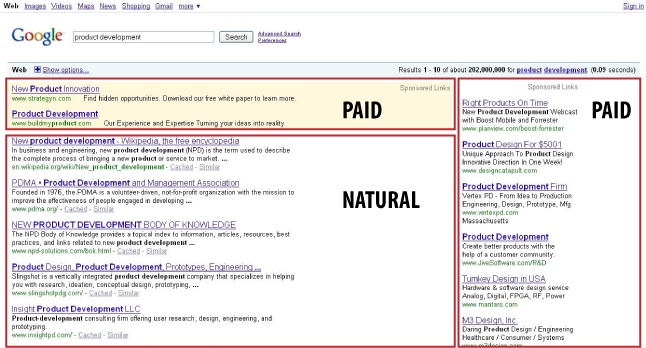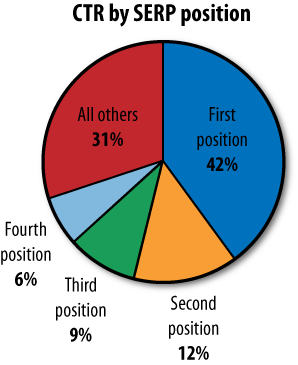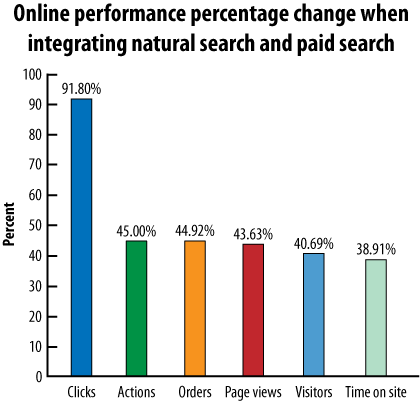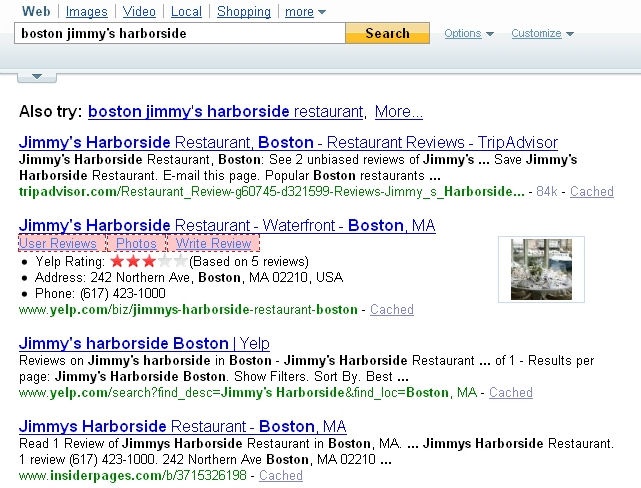By now, you should be convinced that you want to be on the top of the SERPs. It never hurts to be #1 in the natural search results.
In a bit of contrast to that, data shows that you may not want to be #1 in the paid search results, because the resulting cost to gain the #1 position in a PPC campaign can reduce the total net margin on your campaign. A study released by AdGooroo in June 2008 found that:
Bidding for top positions usually makes financial sense only for high-budget, brand-name advertisers. Most other advertisers will find the optimal position for the majority of their keywords to lie between positions 5–7.
Of course, many advertisers may seek the #1 position in paid search results for a number of reasons. For example, if they have a really solid backend on their website and are able to make money when they are in the #1 position, they may well choose to pursue it. Nonetheless, the data from the survey suggests that there are many organizations for which being #1 in paid search does not make sense.
Even if your natural ranking is #1, you can still increase the ranking page’s click rate by having a sponsored ad above it or in the right column. The AdGooroo survey showed that a prominent paid ad on the same search results page makes your #1 natural ranking receive 20% more clicks.
To start breaking this down a bit, Figure 1-10 shows the screen real estate occupied by the two types of search results.
This example from Google shows how the paid results appear above and to the right of the natural search results. Note that Google often does not show paid results above the natural results, in which case the paid results show up only on the right.
Your position in the results has a huge impact on the traffic you will receive. Here is some data about that:
An April 2006 study by iProspect and Jupiter Research found that:
62% of search engine users click on a search result within the first page of results, and 90% within the first three pages.
41% of search engine users who continue their search when not finding what they seek report changing their search term and/or search engine if they do not find what they’re looking for on the first page of results; 88% report doing so after three pages.
36% of users agree that “seeing a company listed among the top results on a search engine makes me think that the company is a top one within its field.”
A study on data leaked from AOL’s search query logs in August 2006 (http://www.webuildpages.com/jim/click-rate-for-top-10-search-results/) reveals the impact of position on the search results on the percentage of clicks received, as shown in Figure 1-11.
In addition, the first 10 results received 89.71% of all click-through traffic; the next 10 results (normally listed on the second page of results) received 4.37%; the third page 2.42%; and the fifth page 1.07%. All other pages of results received less than 1% of total search traffic clicks.
Why are searchers blind to relevant results farther down the page? Is this due to the “implied endorsement” effect, whereby searchers tend to simply trust the search engine to point them to the right thing? Or is it just the way humans are wired, to make snap decisions, as Malcolm Gladwell insightfully explains in his book Blink (Little Brown)?
According to the study, 72% of searchers click on the first link of interest, whereas 25.5% read all listings first and then decide which one to click. Both effects (implied endorsement and rapid cognition) most likely play a role in searcher behavior.
The AOL data in Figure 1-11 demonstrated that natural results get the lion’s share of click results. Further data from the Enquiro, Didit, and Eyetools eye-tracking study shows which results users notice when looking at a search results page (see Table 1-6).
Table 1-6. Visibility of natural search results
Rank | Visibility |
|---|---|
1 | 100% |
2 | 100% |
3 | 100% |
4 | 85% |
5 | 60% |
6 | 50% |
7 | 50% |
8 | 30% |
9 | 30% |
10 | 20% |
Table 1-7 shows the percentage of participants looking at a listing in this location in the paid results.
Notice how the visibility of a listing in the natural results is double or more (up to six times) of the visibility of the same position in the paid results. For example, in position 5 only 60% of users ever even notice the natural search result. But the paid search results fare even worse, with only 10% of users noticing the result in the fifth position.
Here are some additional takeaways from the Enquiro et al. study:
85% of searchers click on natural results.
The top four sponsored slots are equivalent in views to being ranked at 7–10 in natural search in terms of visibility and click-through.
This means if you need to make a business case for natural search, then (assuming you can attain at least the #3 rank in natural search for the same keywords you bid on) natural search could be worth two to three times your PPC results.
It is interesting to note that in spite of this data, companies are much more likely to spend money on PPC than SEO. For example, on June 30, 2008, Jupiter Research released a report (http://news.cnet.com/8301-1023_3-9980927-93.html) showing that search advertising should continue to be the largest category of online ad spending, growing from $9.1 billion in 2007 to $20.9 billion in 2013. That is significant growth.
During the same period, SEMPO data via Massimo Burgio shows that spending on SEO was $1.3 billion, with 11% of search-related budgets going to SEO and 87% to PPC (with another 1.4% to PPC technologies and <1% to paid inclusion).
Clearly, the PPC model is easier for companies to understand because it is more similar to traditional direct marketing methods than SEO is. The ROI of PPC can be tracked and demonstrated more reliably than SEO; thus, to date it has been considered more accountable as a marketing channel. However, as budgets are tightening and the focus is shifting to the highest ROI search investments, the focus is increasingly on SEO.
ICrossing published a report (http://www.icrossing.com/articles/Search%20Synergy%20Report.pdf) that showed a strong synergy between natural and paid search. The study shows what happens when you incorporate natural search into an existing paid search campaign and compare its performance to the performance of the sole paid search campaign. Figure 1-12 summarizes the improvement in the results.
The marked improvement in click-through rate intuitively makes sense. For years marketers have known that the number of impressions a consumer is exposed to will have a dramatic effect on metrics such as retention and likelihood to buy.
A search page provides you with more than one opportunity to put your name in front of the user. You should take advantage of this if you can. It is also useful to understand the difference between natural and paid search. Although some users do not understand the distinction between natural search results and paid search results, it is a well-accepted belief in the industry that the majority of users recognize paid search results as advertisements.
There are many other aspects to consider when thinking about search and your business. Here are some interesting examples:
- Number of visits before purchase
A May 2007 study by ScanAlert showed that only 43% of users who made a purchase on a site made that purchase within an hour of their initial visit to the site. So, to translate that a bit, only 43% of users were likely to have made their purchase upon their first visit to the site. In addition, 26% of purchasers made their purchases after three days or more! This suggests that it is very important for publishers to plan on more complex interactions with users across multiple visits to the site.
- Presentation changes made by the search engines
In February 2008, Yahoo! announced its SearchMonkey platform. This platform allows publishers and developers to directly influence the search results shown when your web pages are included in those results. Figure 1-13 shows a sample search result that demonstrates this.
Notice how the third listing (Yelp) looks different from the rest of the results. The difference in the look of the results really catches the eye, and can significantly impact click-through rates. And it works, as Amit Kumar of Yahoo! recently stated: “Our tests uncovered that users found these apps useful; in fact, in some cases, we saw a lift in click-through rate of as high as 15 percent.”
Get The Art of SEO now with the O’Reilly learning platform.
O’Reilly members experience books, live events, courses curated by job role, and more from O’Reilly and nearly 200 top publishers.





